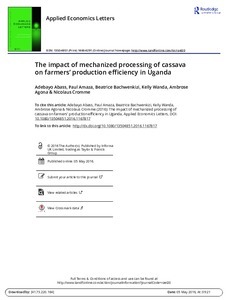| dc.contributor.author | Abass, A. |
| dc.contributor.author | Amaza, P. |
| dc.contributor.author | Bachwenkizi, B. |
| dc.contributor.author | Wanda, K.Y. |
| dc.contributor.author | Agona, A. |
| dc.contributor.author | Cromme, N. |
| dc.date.accessioned | 2019-12-04T10:57:52Z |
| dc.date.available | 2019-12-04T10:57:52Z |
| dc.date.issued | 2016-05-05 |
| dc.identifier.citation | Abass, A., Amaza, P., Bachwenkizi, B., Wanda, K., Agona, A. & Cromme, N. (2016). The impact of mechanized processing of cassava on farmers’ production efficiency in Uganda. Applied Economics Letters, 1-5. |
| dc.identifier.issn | 1350-4851 |
| dc.identifier.uri | https://hdl.handle.net/20.500.12478/859 |
| dc.description.abstract | The study investigates the impact of adopting mechanized processing of cassava on farmers’ production efficiency in Uganda. A stochastic production function, using translog functional form, was used to compare efficiency measures of farmers in mechanized cassava-processing villages compared with the farmers in nonmechanized cassava-processing villages in 2014. Given the specification of the translog production function, the mean technical efficiencies of the farmers were 0.69 and 0.52 in mechanized and nonmechanized villages, respectively. The significant determinants of technical inefficiency among the respondents are farming experience, education, membership of farmer association, access to markets, sale of cassava to processors and farmers who planted cassava as sole crop are all negative, which confirm to a priori expectations and significant at different levels. The policy implication of the study is that mechanization of cassava processing, particularly if done at the right scale, could create demand that can transform primary production for increased yields, higher incomes and production efficiency of smallholder farmers who constitute a significant proportion of Uganda’s agricultural sector. |
| dc.format.extent | 1-5 |
| dc.language.iso | en |
| dc.subject | Cassava |
| dc.subject | Processing |
| dc.subject | Efficiency |
| dc.title | The impact of mechanized processing of cassava on farmers' production efficiency in Uganda |
| dc.type | Journal Article |
| dc.description.version | Peer Review |
| cg.contributor.crp | Roots, Tubers and Bananas |
| cg.contributor.affiliation | International Institute of Tropical Agriculture |
| cg.contributor.affiliation | University of Jos |
| cg.contributor.affiliation | National Agricultural Research Organisation, Uganda |
| cg.contributor.affiliation | Common Fund for Commodities |
| cg.coverage.region | Africa |
| cg.coverage.region | East Africa |
| cg.coverage.country | Uganda |
| cg.isijournal | ISI Journal |
| cg.authorship.types | CGIAR and developing country institute |
| cg.iitasubject | Cassava |
| cg.journal | Applied Economics Letters |
| cg.howpublished | Formally Published |
| cg.accessibilitystatus | Open Access |
| local.dspaceid | 75350 |
| cg.targetaudience | Scientists |
| cg.identifier.doi | https://dx.doi.org/10.1080/13504851.2016.1167817 |

